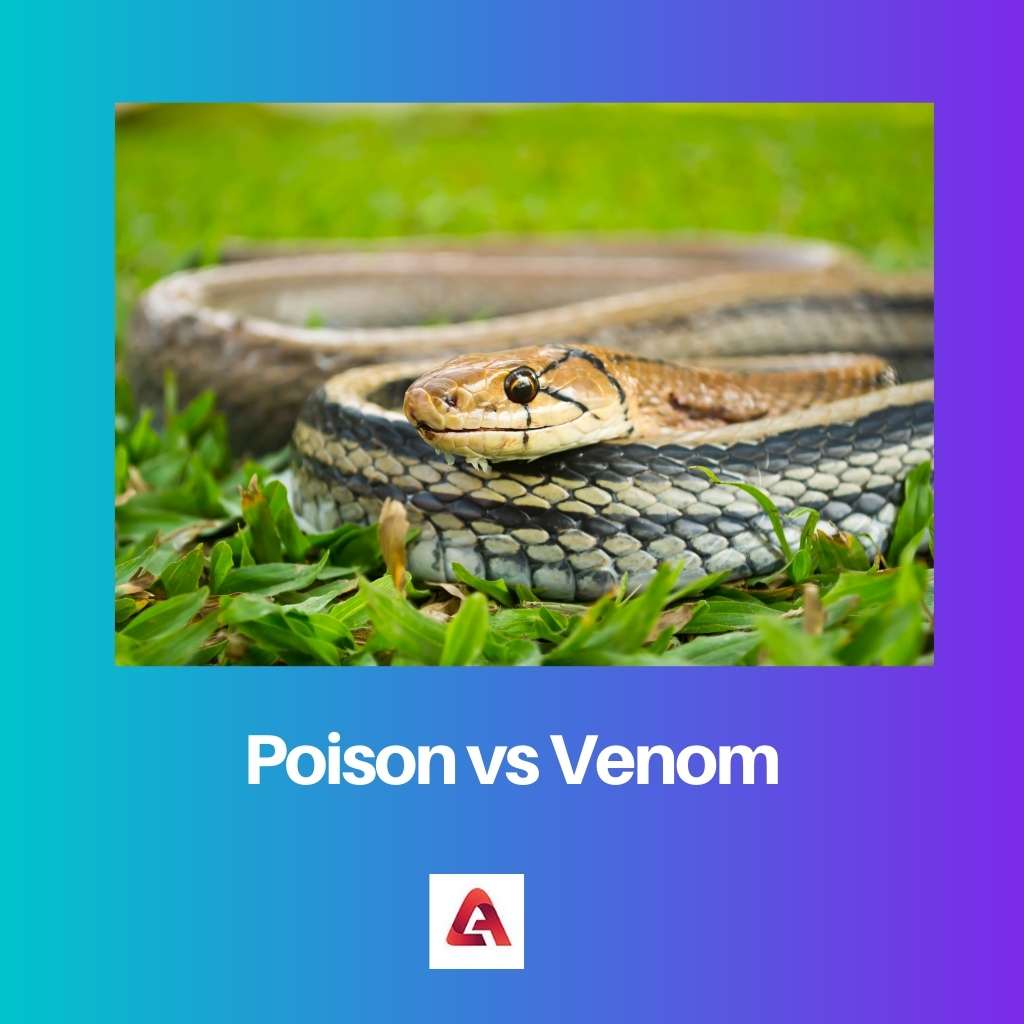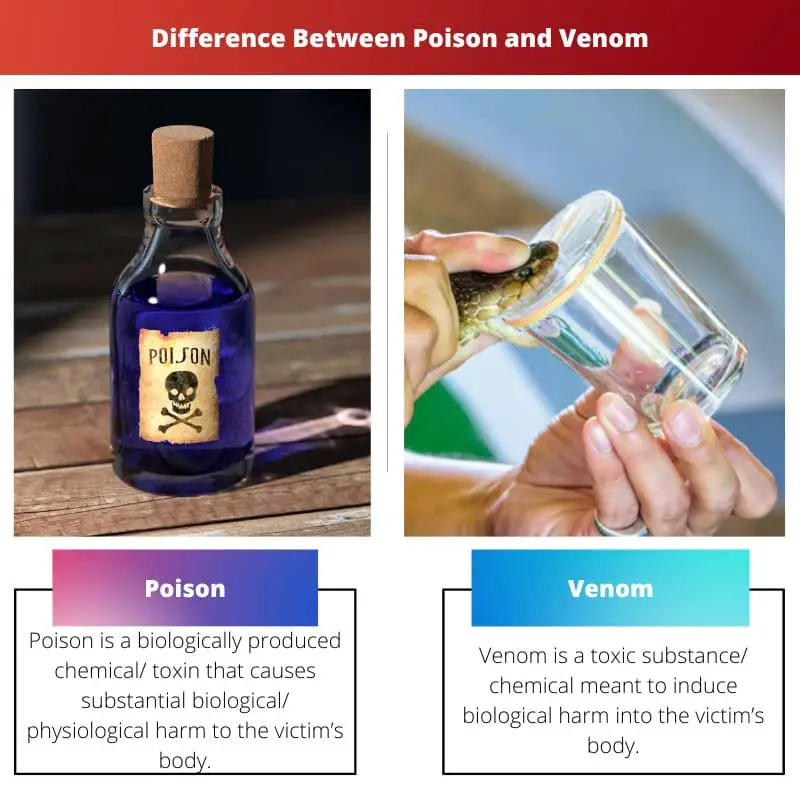Poison and Venom (both) are toxins i.e., substances that induce substantial harmful biological and physiological effects into the victim’s body.
Animals primarily use them to subdue their prey to defend themselves, but they can also result in the victim’s death. They function effectively when delivered correctly.
Key Takeaways
- Poisons are harmful substances that cause adverse effects when ingested, inhaled, or absorbed through the skin, while venoms are toxins injected by animals through bites or stings.
- Poisonous animals, like poison dart frogs, release toxins passively, whereas venomous animals, like snakes, actively deliver venom.
- Antivenom treats venomous bites or stings, but there is no universal antidote for poisons, as treatment depends on the specific substance involved.
Poison vs Venom
The difference between Poison and Venom is that Poison is delivered to the victim’s body using touch, inhalation, ingestion, and absorption through the skin. In contrast, Venom reaches the victim’s body via a bite or sting. Both substances subject the victim to physical harm and are effective when delivered correctly.

Poison is a toxin delivered by a poisonous organism into the victim’s body through touch, ingestion, absorption through the skin, and inhalation.
Poisonous animals are unable to choose when to apply their toxins. Ingestion of Poison is a scarce occurrence; absorption into the victim’s skin is the standard way of transfer.
Venom is a specialized type of Poison that has evolved for specific purposes.
It is a mixture of small and large molecules, so to be effective, it finds its way into the bloodstream via a wound induced by a sting or bite.
Comparison Table
| Parameters of Comparison | Poison | Venom |
|---|---|---|
| Mode of Delivery | Secreted via skin | Actively injected via sting or bite |
| No possibility as poisonous animals cannot choose when to apply their toxins. | Ingestion, Inhalation, Absorption through the skin | Venomous molecules are injected into the bloodstream |
| Purpose Behind Application | Deter potential predator/ Subdue prey | Knock out or kill prey |
| Possibility of Selective Use | It can be used selectively; Not all stings/ bites are venomous | Can be used selectively; Not all stings/ bites are venomous |
| Artificial Presence | Lead, Arsenic, Mercury | Pharmaceuticals |
What is Poison?
Poison is a biologically produced chemical/ toxin that causes substantial biological/ physiological harm to the victim’s body.
Poisonous animals use it to deter potential predators but is also capable of killing the victim.
Because they tend to be passive-aggressive, poisonous creatures also secrete Poison, ergo of being disturbed via touch or when eaten.
It is secreted through their skin, but in addition to absorption through the skin, it can also enter the victim’s biological system via ingestion and inhalation.
Poisonous creatures cannot choose to be toxic at a particular time as they constantly produce/ secrete toxins.
Thus, poisons can be absorbed through body tissue, but they’re also present in elements other than plants and animals.
Secretion of Poison via the poisonous animal’s skin and its absorption by the victim’s skin is a standard means of delivery. Hence ingestion is a scarce occurrence.
Poisonous creatures use Poison as a weapon to subdue their prey or to deter possible predators. They cannot use it selectively.
Numerous chemical elements like lead, arsenic, and mercury are poisons and not found in the body of any living organism.

What is Venom?
Venom is a toxic substance/ chemical that induces bodily harm into the victim’s body. It is primarily used by venomous animals (like snakes) to knock out or kill their prey.
Its usual means of introduction into the victim’s body is a sting or bite via fangs, teeth, or spiny protrusions on the animal’s body.
Being a mixture of small and large molecules, it enters the victim’s body via a sting or bite and then finds its way into their bloodstream to act effectively.
However, venomous animals don’t always inject venom when they bite.
Referred to as ‘Dry Bites’, these wounds are stings/ bites that do not involve the venom transfer from the vicious animal to the victim’s bloodstream.
Thereby, venomous creatures do not produce venom constantly and can choose when to administer their poison.
Venom is not necessarily poisonous because it won’t cause harm when touched or ingested.
To consider its modern applicability in the domain of pharmaceuticals, with advancements in scientific studies and research, several venom components were used in the design of new therapeutic agents.
They were also taken in as experimental molecules to validate postulated therapeutic targets, ultimately improving several drug libraries.
Main Differences Between Poison and Venom
- Poison is induced into the victim’s body by absorption through the skin, inhalation, ingestion, etc., but Venom is directly induced into the victim’s bloodstream employing a bite or sting.
- Poisonous Creatures produce toxins constantly and cannot choose whether to be toxic, but Venomous Creatures can choose when to administer their venom.
- Poisonous Creatures inhabit a passive-aggressive tendency to respond to threats. Venomous Creatures are more active in defending themselves.
- Poison, moreover accomplishes the motive of subduing a natural prey or deterring a possible predator. In contrast, venom is more harmful because it is known to be strong enough to knock out and kill the victim.
- Poisons exist in the form of chemical elements like Lead, Mercury, and Arsenic, whereas Venom components are actively used in the domain of pharmaceuticals to design new therapeutic agents.

- https://www.sciencedirect.com/science/article/pii/S1874391912001340
- https://www.sciencedirect.com/science/article/pii/0041010183900557

The article offers a comprehensive exploration of poisons and venoms, distinguishing their modes of delivery and purposes. The scientific approach and detailed explanations make it an engaging piece that contributes to a better understanding of these toxic substances.
The author presents a compelling argument based on scientific evidence to explain the essential differences between poisons and venoms. The comparison table is pragmatic and effectively illustrates these distinctions. This article is an excellent resource for those interested in toxicology and biology.
Absolutely, Xreynolds. It’s refreshing to see such a well-researched piece that delves deeply into the subject matter. The insights provided in the writing are invaluable, and it’s clear that the author has a profound understanding of the topic.
The post does an excellent job of highlighting the key takeaways about poisons and venoms. The comparison table is especially helpful for understanding the differences between these toxic substances. It’s clear and well-organized, making it easy to comprehend.
This article is extremely informative. It provides an in-depth analysis of poisons and venoms, and their methods of delivery, as well as their effects on victims. I am very impressed with the comprehensive details provided and the way the differences between them are so clearly explained.
The post sheds light on the differences between poison and venom in a precise and insightful manner. It’s evident that the author has put significant effort into researching this topic, and the well-cited references add further credibility to the content. An enlightening read overall.
The content of this article is both educational and interesting. I believe this information should be shared more widely to increase awareness about the dangers of poisons and venoms. The references provided also lend credibility to the material. I would love to see more discussions around this topic.
I agree, Tanya71. There is a lot of value in this article, and it would definitely benefit a broader audience. The detailed descriptions and scientific references make it a reliable source of knowledge on the subject.